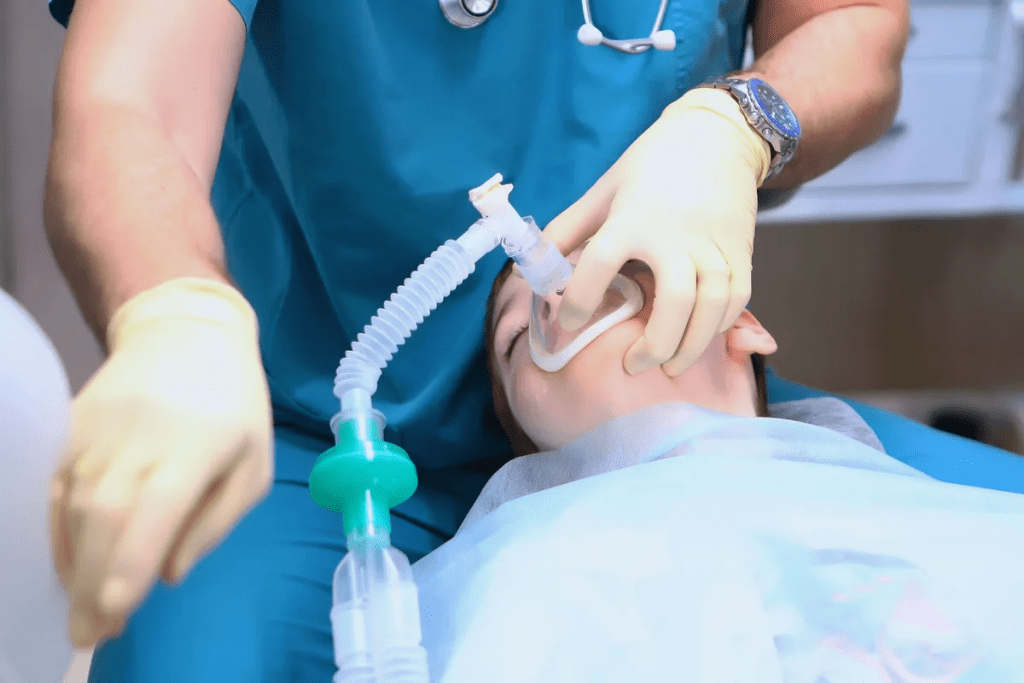Last Updated on November 14, 2025 by

For years, doctors thought babies didn’t feel pain like adults. But research has shown this is not true. It’s crucial to care for young patients properly.
At Liv Hospital, we’ve learned a lot about infant anesthesia and pain relief for babies. The invention of anesthesia started a new chapter in medicine. Now, we focus on our patients’ health, using the latest research and technology to provide the safest care.
Our understanding of infant pain has changed a lot over time. We used to believe things that were not true about how to care for babies. This has made a big difference in how we help them today.
One big mistake was thinking babies don’t feel pain like grown-ups do. This led to many surgeries on babies without enough anesthesia. We now know this was very wrong and caused a lot of pain.
People thought babies couldn’t feel pain because their nervous system was not fully grown. But studies have shown that babies can feel pain. It’s very important to help them with pain to avoid long-term problems.
Big surgeries were done on babies without enough pain relief. This was because people thought babies didn’t feel pain. Things like circumcision and heart surgery were done without the right pain care.
Now, we know that infants and anesthesia is a key part of taking care of them. Giving anesthesia to babies needs careful thought and knowing how their bodies work differently.
Our new understanding has changed how we manage pain in babies. Today, we make sure to use the right anesthesia and pain relief for babies having surgery.
In 1987, a groundbreaking study changed how doctors treat infants during surgery. It showed that babies feel pain just like adults. This discovery was key to improving how we care for infants during anesthesia.
The 1987 study looked at how infants react to surgery without enough anesthesia. It found that infants’ stress responses were three to four times higher than adults’. This proved that babies do indeed feel pain.
“The study’s findings were a wake-up call for the medical community, highlighting the need for appropriate anesthesia in infant surgical procedures.”

The 1987 study’s results greatly impacted how doctors work. It led to a big change in how anesthesia is given to infants. Now, we make sure babies get the right pain relief during surgery. This is thanks to the research done at Liv Hospital.
By looking back at the history of infant anesthesia, we see how far we’ve come. Today, using general anesthesia on infants is common. This is all thanks to the research from the late 20th century.
The history of infant anesthesia is a journey from the 19th century to today. It’s about understanding how to manage pain in babies. We’ve made big steps in this field, and it’s important to know the key moments.

Anesthesia started in the mid-19th century with ether and chloroform. The first use of ether was in 1842 by Dr. Crawford Long. But, it wasn’t used on babies right away.
People thought babies didn’t feel pain. It took time to learn they do. Then, anesthesia started being used more in kids.
Anesthesia was slow to come to kids. There were worries about its safety and how well it worked. It wasn’t until the 20th century that things really changed.
Studies and new tech helped a lot. We learned more about how babies feel pain. This led to better ways to give them anesthesia.
Now, we have special anesthesia protocols for kids. These help manage pain for different surgeries. From neonatal surgeries to big operations, anesthesia is key in pediatric care.
Thanks to specialized pediatric anesthesiologists and new tech, anesthesia is safer. This means we can help our youngest patients less painfully and with less stress.
Today, general anesthesia is safely given to infants thanks to medical research. At Liv Hospital, we follow the latest guidelines and protocols. This ensures our patients get the best care possible.
The use of general anesthesia in infants is backed by a lot of research and guidelines. Modern methods are designed to keep infants safe during anesthesia. We carefully evaluate each patient before surgery, use the right amount of anesthesia, and watch them closely during the procedure.
Every year, over 6 million pediatric anesthetics are done in the US. This shows how crucial this part of pediatric care is. We update our protocols often to keep up with new research, ensuring top-notch care for our patients.
Newborns and premature babies need special consideration because their bodies are still developing. We adjust our anesthesia plans to fit their needs, making sure they are safe and comfortable during surgery. This includes choosing the right anesthesia, using the right amount, and watching them closely.
The way we use general anesthesia newborn has gotten much better, thanks to ongoing research. Our team works hard to keep up with these advancements. This way, we can give our patients the best care available.
We’ve made big strides in understanding the need for pain relief in babies. This shift from ignoring baby pain to using advanced pain relief methods is a big step forward. Now, we know that babies and kids have the right to feel less pain, and we act on it.
Things like circumcision, once done without thinking about pain, now use anesthesia to reduce discomfort. At Liv Hospital, we’re dedicated to keeping this progress going. We aim to give our patients the best care, always looking to improve how we manage pain in kids.
Looking ahead, we must keep improving our knowledge and methods. This way, we can make sure that babies and kids get the care they deserve. This includes using the right anesthesia for procedures like circumcision when it’s needed.
Anesthesia started being used in infants after research showed they feel pain. A key 1987 study on infant pain during surgery was a big change.
Yes, babies get anesthesia for circumcision. This shows doctors now know they need pain relief.
Anesthetics were first used in the 19th century. But, it took a long time to use them in kids. Advances in medicine and tech made it common in pediatric care.
Today’s anesthesia protocols for infants are safe and consider their special needs. They’re based on lots of research and guidelines.
At first, people thought babies didn’t feel pain like adults. But research proved they do. This changed how we manage pain in babies.
Anesthesia for babies became more common after the 1987 study on infant stress during surgery. This study was a big step forward.
Infants need anesthesia for many surgeries and some minor procedures like circumcision. The need depends on the procedure and the baby’s needs.
Over 6 million pediatric anesthetics are done each year in the US. This highlights how crucial it is for kids’ care
Subscribe to our e-newsletter to stay informed about the latest innovations in the world of health and exclusive offers!